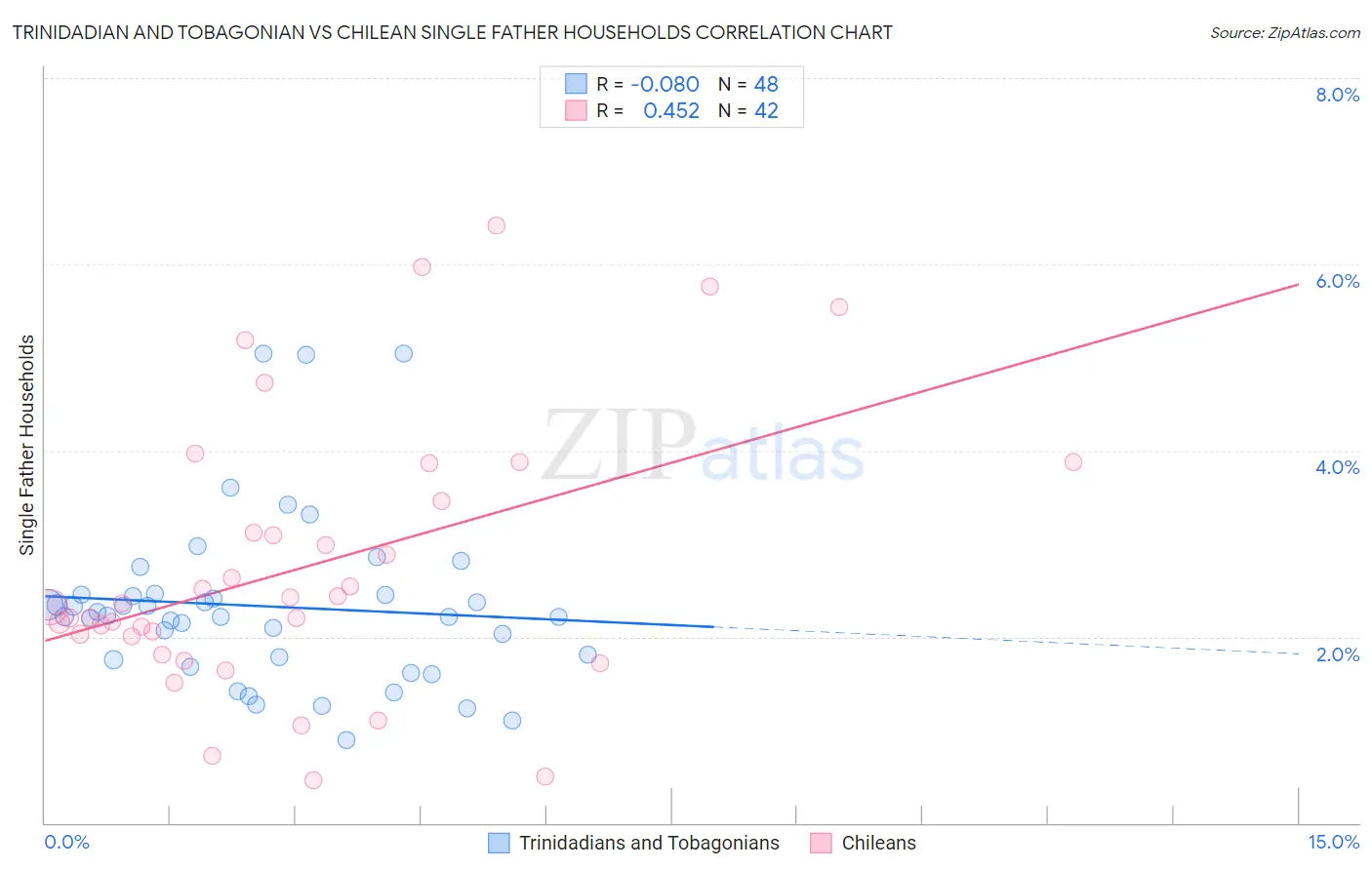Trinidadian and Tobagonian vs Chilean Single Father Households
COMPARE
Trinidadian and Tobagonian
Chilean
Single Father Households
Single Father Households Comparison
Trinidadians and Tobagonians
Chileans
2.2%
SINGLE FATHER HOUSEHOLDS
97.8/ 100
METRIC RATING
119th/ 347
METRIC RANK
2.2%
SINGLE FATHER HOUSEHOLDS
94.5/ 100
METRIC RATING
136th/ 347
METRIC RANK
Trinidadian and Tobagonian vs Chilean Single Father Households Correlation Chart
The statistical analysis conducted on geographies consisting of 218,763,381 people shows a slight negative correlation between the proportion of Trinidadians and Tobagonians and percentage of single father households in the United States with a correlation coefficient (R) of -0.080 and weighted average of 2.2%. Similarly, the statistical analysis conducted on geographies consisting of 255,538,332 people shows a moderate positive correlation between the proportion of Chileans and percentage of single father households in the United States with a correlation coefficient (R) of 0.452 and weighted average of 2.2%, a difference of 1.9%.

Single Father Households Correlation Summary
| Measurement | Trinidadian and Tobagonian | Chilean |
| Minimum | 0.89% | 0.46% |
| Maximum | 5.0% | 6.4% |
| Range | 4.2% | 6.0% |
| Mean | 2.3% | 2.7% |
| Median | 2.2% | 2.3% |
| Interquartile 25% (IQ1) | 1.8% | 2.0% |
| Interquartile 75% (IQ3) | 2.5% | 3.5% |
| Interquartile Range (IQR) | 0.69% | 1.5% |
| Standard Deviation (Sample) | 0.92% | 1.5% |
| Standard Deviation (Population) | 0.91% | 1.4% |
Demographics Similar to Trinidadians and Tobagonians and Chileans by Single Father Households
In terms of single father households, the demographic groups most similar to Trinidadians and Tobagonians are Australian (2.2%, a difference of 0.030%), Immigrants from Brazil (2.2%, a difference of 0.040%), Immigrants from Morocco (2.2%, a difference of 0.060%), Immigrants from Iraq (2.2%, a difference of 0.13%), and Hungarian (2.2%, a difference of 0.16%). Similarly, the demographic groups most similar to Chileans are Austrian (2.2%, a difference of 0.11%), Syrian (2.2%, a difference of 0.12%), Zimbabwean (2.2%, a difference of 0.23%), Taiwanese (2.2%, a difference of 0.83%), and Polish (2.2%, a difference of 0.94%).
| Demographics | Rating | Rank | Single Father Households |
| Hungarians | 97.9 /100 | #117 | Exceptional 2.2% |
| Immigrants | Morocco | 97.8 /100 | #118 | Exceptional 2.2% |
| Trinidadians and Tobagonians | 97.8 /100 | #119 | Exceptional 2.2% |
| Australians | 97.7 /100 | #120 | Exceptional 2.2% |
| Immigrants | Brazil | 97.7 /100 | #121 | Exceptional 2.2% |
| Immigrants | Iraq | 97.6 /100 | #122 | Exceptional 2.2% |
| Immigrants | Yemen | 97.5 /100 | #123 | Exceptional 2.2% |
| British West Indians | 97.4 /100 | #124 | Exceptional 2.2% |
| Immigrants | Indonesia | 97.4 /100 | #125 | Exceptional 2.2% |
| Moroccans | 96.9 /100 | #126 | Exceptional 2.2% |
| Jordanians | 96.9 /100 | #127 | Exceptional 2.2% |
| Immigrants | England | 96.8 /100 | #128 | Exceptional 2.2% |
| Serbians | 96.8 /100 | #129 | Exceptional 2.2% |
| Immigrants | Chile | 96.7 /100 | #130 | Exceptional 2.2% |
| Immigrants | Jordan | 96.6 /100 | #131 | Exceptional 2.2% |
| Poles | 96.5 /100 | #132 | Exceptional 2.2% |
| Taiwanese | 96.3 /100 | #133 | Exceptional 2.2% |
| Zimbabweans | 95.1 /100 | #134 | Exceptional 2.2% |
| Syrians | 94.8 /100 | #135 | Exceptional 2.2% |
| Chileans | 94.5 /100 | #136 | Exceptional 2.2% |
| Austrians | 94.2 /100 | #137 | Exceptional 2.2% |